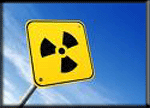
Radon
Radon is a colorless and odorless radioactive gas that has been estimated to cause 5,000 to 20,000 lung cancer deaths yearly. It is second only to smoking as a cause of lung cancer. It has been estimated that nearly 1 out of every 15 homes in the US has elevated radon levels.
Radon is produced when small amounts of uranium and radium in soil and rocks decay. Radon gas will also decay into smaller and radioactive particles that can be inhaled into the lungs where it can damage cells and cause lung cancer.
Radon is mainly released from soil, water and natural gas which have already been exposed to radon, from solar-heating systems that use radon-emitting rocks, and from uranium or phosphate mine tailings. Radon is naturally released in low concentrations, but inside your house, radon gas can become more concentrated. Lack of ventilation exhaust fans that bring in air from outside can increase the amount of radon in your home.
The Environmental Protection Agency suggests that homes be tested for radon, which should have a radon level of 4 picocuries per liter or less. For people selling their homes, the EPA recommends that the house be tested for radon, and radon levels be reduced, if necessary. Radon levels can be reduced by increasing the airflow into the house, keeping the vents open year round, and discouraging smoking in the house. For people buying homes, the EPA recommends obtaining radon test results in addition to information about radon reduction systems.
If you are planning to have your home tested for radon, the EPA recommends that the test be conducted in the lowest level of the home that is suitable for occupancy, and you should make sure that the test is done correctly by following the EPA Test Checklist.
There are two different types of testing devices available: passive devices and active devices. Passive devices, such as charcoal canisters, alpha track detectors, and charcoal liquid scintillation devices are exposed to air in the home for a specified amount of time, and sent to a laboratory to be analyzed. Active devices, like continuous radon monitors and continuous working level monitors, continuously measure and record the amount of radon in the air, and require operation by trained testers. These tests can be performed over a long term, or a short term, with the long term tests by active devices considered to be more accurate.
Back To Homeowner Info
|